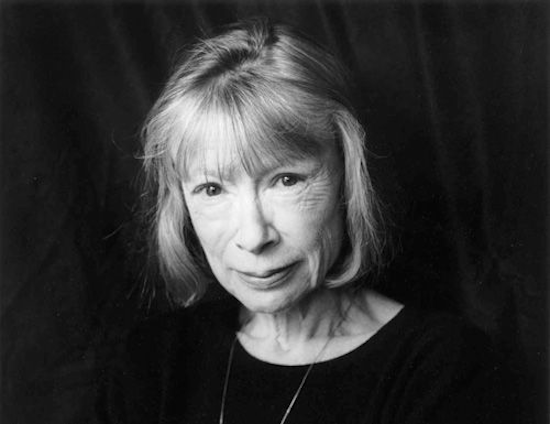Here’s Joan Didion on roving reporter mode at a Gamblers Anonymous meeting in Gardenia, the draw-poker capital of Los Angeles County. A penitent says their ideal, the aim of the programme, is “getting serenity”. Didion balks at that: she associates serenity with death. Joan doesn’t do serenity: she’s been proven right in her anxieties for decades.
It’s 2021 and entirely appropriate to be nervous now. Didion, perhaps more than any other contemporary American writer, grasps the sadness in the deluded idea of the good life and Let Me Tell You What I Mean is a reminder, if one was needed, of her perspicacity.
Didion has long delighted in shattering delusions. Visiting William Randolph Hearst’s castle at San Simeon she reviews the proposition that “all the pleasures of infinity are to be found in the here and now’ and promptly finds evidence to the contrary. Any putative happiness that once resided in this ludicrous Xanadu she sees as a tragic illusion. Its continued existence, she concludes, reflects the idiocy of idolising the rich.
Didion’s sentences have been worked and reworked as much as Hemingway’s. She writes here of her hero’s “deceptively simple sentences”: when she first reads him aged “twelve or thirteen” she counts the number of words he uses for best effect. She notices where Hem puts his commas and his use of ‘the’ and ‘and’: their rhythm. She feels too the “power of a paragraph”.
Like Hemingway, words truly matter for her, all of them. Confronted by the late novels Hemingway did not want published she is horrified to read that Mary – his fourth wife – allowed their release under the titles Islands in the Stream and The Garden of Eden. She quotes Mary justifying her decision thus: “Except for the punctuation and the obviously overlooked ‘ands’ and ‘buts’ we would present his prose and poetry to readers as he wrote it letting the gaps lie where they were”. Didion is outraged and insists: “you care about the ‘ands’ and the ‘buts’ or you don’t”.
Likewise, she tears into a Berkeley professor of English after dinner when said academic concludes that Fitzgerald’s The Last Tycoon was proof that Scott was a “bad writer”. Didion, ludicrously, has to stress over the digestifs that the manuscript was unfinished.
And then there are her views on the media. It’s 1968 and she’s talking about mainstream American newspapers. She says the vast majority leaves her “in the grip of a profound physical conviction that the oxygen has been cut off from my brain tissue”. She favours “the underground press”, those that reflect “the special interests of the young and disaffiliated” whose “particular virtue is to be devoid of conventional press postures”. (Thinking this over, we might hope she would approve of tQ, maybe even consider taking out a subscription.)
Didion is a great encourager. In ‘Telling Stories’ she outlines her own intimidating experiences as nineteen year-old at a writers’ workshop. Her simple message is persist. Working for Vogue trained her in précis, how to regard words as “tools, toys, weapons to be deployed strategically on a page.” At the magazine “not every word but every letter counted”. She’s telling budding writers to never give up and goes on to recount the humiliating trials of one of her own stories, eventually accepted by the Denver Quarterly for the miserly sum of $50. Before then it had been rejected (one typical review: “it’s really a well worked-out story”) by, amongst others: Cosmopolitan, Good Housekeeping, Esquire, Harper’s Bazaar, Vogue (!), Mademoiselle, Paris Review, Yale Review. Count ‘em; the list goes on and on.
She takes delicious late revenge on the Dean of Admissions at Stanford who owns the wonderfully Pynchon-esque name of Rixford K. Snyder. He wrote her a rejection letter and Didion’s essay ‘On Being Unchosen by the College of One’s Choice’ is a must-read for any kid who feels tears welling up after getting the Big No. But more importantly her message is for parents too. Don’t let your expectations get in their way. Let them get there by themselves. Like Joan’s dad when he heard the news: shrug and offer them a drink.
Didion can be her own sternest critic asking of a tale she’d written: “What is that Kentucky coal mine doing in the story”. There’s only one problem with this admonition – it points you straight back to Hinton Als’ otherwise fine introduction where he tells us Didion has a brother called Jim who was born in 1939. And? I’ve read the introduction several times now and cannot for the life of me work out why we’re told this fact. I’m probably missing something obvious. But Didion’s teachings ask us to up our game. Watch out for redundancy.
The key essay here is ‘Why I Write’, a wonder of compression. Pinching Orwell’s title – there’s chutzpah for you – Didion admits she is not a scholar; that she does not think “in abstracts’. She hones in on the tangible, admits honestly that she writes “entirely to find out what I’m thinking, what I’m looking at, what I see and what it means”. Long may she continue to do so. Joan Didion, one of the last great romantic individualists, is now 89.
Let Me Tell You What I Mean by Joan Didion is published by 4th Estate


